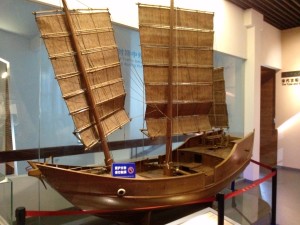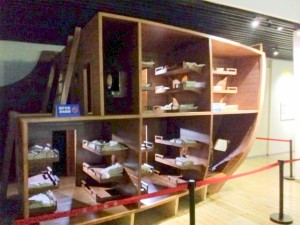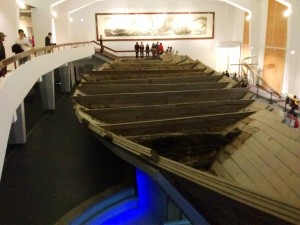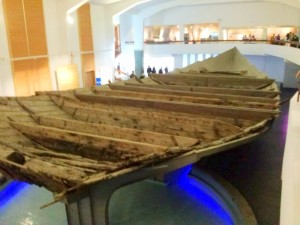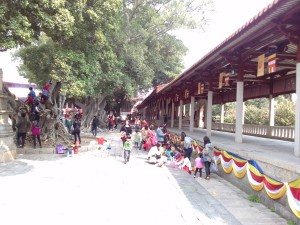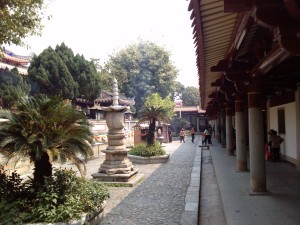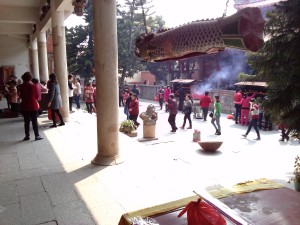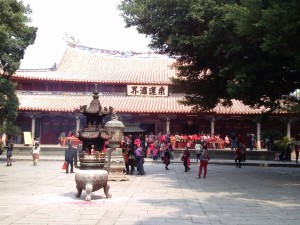Went by train up the coast on a pilgrimage to the city of Quanzhou.
Expected a small town but encountered yet another big sprawling Chinese city. At 6 million people the biggest city in Fuzhou province. When China was open between say 1000 and 1400 this was one of the largest and most important ports in the world.
There were trading ports up and down this coast, but Quanzhou was by far the most important. The great Chinese discovery voyages left from here. The Khan’s fleet to invade Java left from here. And Marco Polo departed China for home from here, and that is why I came.
There were perhaps 100,000 Arabs living on this coast at the time, and in retrospect Quanzhou was named the beginning of the Arab Silk Road. Exports of silk, porcelain, tea were the Chinese trade goods. The city state of Venice had the monopoly with the Arabs for ongoing shipments into Europe, hence the great wealth of that city during this period. Hence the tremendous efforts of the Portuguese to find a trade route around Africa and around the Venetians. Entrepreneurs like Marco’s father and uncle attempted overland routes to China.
There were Portuguese here by the 1300’s. Great sailors. I have journeyed to Lisbon to pay homage to Henry the Navigator. But they were pretty much despised in Asia. Their flavor of twelfth century Christianity afforded them huge arrogance and over the top acts of savagery against non-believers. In Calcutta they filled a boat with hands and feet and promised one every day until the city was opened to them. Here in China, the Kahn was finally so pissed off over their raiding and murdering that he ordered the Portuguese to be “killed on the spot where they are encountered”. Their garrison at Quanzhou was attacked and the survivors fled to Macau.
I became interested in the stories Marco Polo told when I found myself spending a lot of time in some of the cities he described. Especially two of my favorite Chinese Cities, Hangzhou and Suzhou.
He arrived at a very interesting time in Chinese history. Everyone does. I was in a museum last week looking at 5000 year old artifacts. And once visited a 6500 year old village where the pots were marked with the origins of Chinese writing. While we had Mesopotamia and the Greeks and the Romans and all the rest, they were here independently going on with their own civilization.
Anyway, so a group called the Jin invaded China from the North and the Song Dynasty (say 650 to 1300) moved down the Grand Canal and set up the capital of China at Hangzhou, where the Grand Canal reaches the sea. This is around say the mid 1200s. But the Jin were overextended, and the Great Kahn, Kublai Kahn, came down, kicked them out, moved into Beijing, and began to rule the north of China. Marco Polo’s father was just arriving in China about this time and was reported to be the first westerner the great Kahn ever met. Anyway, they hit it off and Marco’s father brought a fortune in goods back to Italy and met his grown son Marco and they turned around to go back for more.
Marco Polo arrived in Beijing around 1270 to 1275ish. But he spent a lot of time down the Grand Canal around Suzhou and Hangzhou for reasons I do not know. The Song were falling to the Kahn around then and the capital would soon move back to Beijing. We know that Marco got caught up in some military advisory capacity, so perhaps this was it.
Everyone knows about the Great Wall of China. But it is a surprise to me that another of the truly magnificent achievements of the ancient world: the Grand Canal is hardly ever mentioned. It is both gigantic and astounding. It is an artificial river, wide enough for two very large barges to pass and it runs for 1100 miles connecting Beijing with 5 interior rivers and the sea at Hangzhou! It was completed in about 600 AD, and allowed China to have a safe interior transportation and trade route for centuries.
When Marco arrived in Hangzhou in the late 1200’s it would have been as he describes it a magnificent city. The Imperial Capital, the southern harbor, open to the sea and via the canal to the interior. With around a million people easily the largest city on earth.
But back to Quanzhou.
Marco Poly was allowed to leave China and came to Quanzhou to join a fleet of 14 Junks carrying a 17 year old Mongol girl to be a bride to the ruler of Persia (roughly Iran), a relative of the Kahn. Here are some photos of a model of the kind of Song Dynasty Junk he would have left on.
And here is the keel of an actual Song Dynasty Junk recovered from a ship wreck that gives you an understanding of the size of these fully ocean going vessels.
There is nothing left at the ancient harbor. But some nearby pagodas and this ancient temple. So I sat here with the Buddhists for a while.
And indulged my self with the thought that Marco might have visited here before his fantastic journey home. Around Thailand and Malaysia. Around India. Up the red sea. By caravan to the Mediterranean Sea then by boat to Italy. Facing that he might have come here for a few good luck prayers. A few joss sticks. Sitting here dressed as a Mongol Baron. His fortune converted into precious jewels and sewn into his clothes.
Besides overlapping with Marco in Beijing, Xian, Suzhou and Hangzhou I have even dragged Cathy to the edge of the Gobi desert where the great wall ends, where Marco Polo entered China and to follow some of his route southeast. That journey turned out to be more interesting than I expected because this is also the route through which Buddhism entered China, leaving a plethora of very ancient historic sites.
With this pilgrimage to Marco’s departure site I have pretty much completed this little quest of mine.
Today is my last day in China. I am looking forward to hosting myself to a really good farewell dinner. And moving on.
————————————————–
Some random musings about Suzhou and Hangzhou.
I used to love visiting Hangzhou. Today it is effectively a suburb of Shanghai, quickly accessible by train. But my first visit took me 5 hours on dirt roads to arrive at a little one to two story village on the north end of the famous west lake. Today the city circles the lake with high rises. I guess I have been there every 8 or ten years or so, watching it change. First responsible to establish a manufacturing joint venture, years later to buy a local company. A few times just to visit.
Even 30 years ago there were 200,000 tourists a year visiting Hangzhou. Because the west lake is the most romantic site in China. The moment of the full moon rising over West Lake is by tradition the most romantic moment on earth. It is a special place with warm memories for me.
Marco described Suzhou as the Venice of China. Much of the old areas are being torn down as Shanghai inexorably creeps to take it from the east. I once took Cathy to these cities. In Suzhou we hired a boat and poked around the old canals. Walked some ancient streets. Visited some remaining garden homes of the Scholar Officials. Suzhou is a very old town occupying a strategic position on the Grand Canal with an amazing history. One chapter is worth a quick summary. Probably not perfect, but here is the way I remember it.
With the collapse of the Ming Dynasty in the mid 1600’s the new rulers, the Manchus were suspicious of the power of the Mandarin Scholar Officials. Since these Mandarin had the virtual monopoly on reading and writing and transmitted all imperial decrees, proclamations and information throughout the country the Manchus were probably right. So, they set about to weaken and circumvent the Mandarin system of high official selection based upon a hierarchy of intelligence and knowledge tests and a consensus around a person’s competence and ability. This was a thousand plus year old system.
Many ministers saw the writing on the wall and took themselves off to early retirement. A good number went down the Grand Canal a distance out of easy reach from Beijing, to Suzhou. They were very very rich and from their positions we can guess very competent brilliant people. So after building their houses and gardens they could only spend so much time painting, making music, writing poetry, and admiring nature, their traditional areas of ongoing learning when not governing.
So, as the generations passed these families built elementary schools, trade schools, western style universities. Undertook civic improvements, roads, lighting, and security. Sent students abroad for study at foreign universities, and delegations to study of foreign industries. Established local banks, manufacturing of silk, dying, silk products.
And the most interesting story (maybe only to me) is how as the French and Americans expanded their trading city at nearby Shanghai, the Suzhou families leveraged the nearness of the trade and technical and financial opportunities. This continues to play out with Suzhou today having a standard of living comparable to Portugal. If I could write, this is a story I would like to tell. But it is probably already on the internet somewhere.
